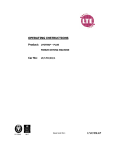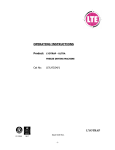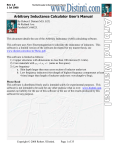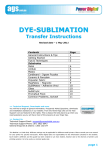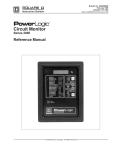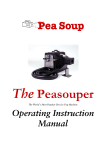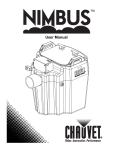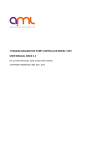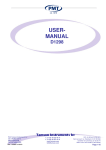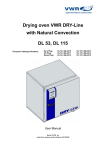Download LYOTRAP FREEZE-DRYING MACHINE OPERATING INSTRUCTIONS
Transcript
LYOTRAP FREEZE-DRYING MACHINE OPERATING INSTRUCTIONS User Manual for Lyotrap Freeze-Drying Machine The precise answer to controlled environments 2 User Manual For Lyotrap Freeze-Drying Machine Manual Ref. No: UM0019 Machine Serial No: …................ Pressure Vessel Ref: Issue No: 001 Software Ref: …................ …................ Description Of Any Options Fitted: ….............................................................................................................................. .................................................................................................................................. .................................................................................................................................. .................................................................................................................................. ............................................. Voltage: Power: Phase: It would be most helpful if you could have the above information available when requesting technical advice or after sales service. C H Perry Chairman, LTE Scientific Ltd 3 Confidentiality All rights reserved. No part of this publication may be reproduced, stored in a retrieval system, or transmitted in any form or by any means, mechanical, photocopying, recording, or otherwise, without the prior written permission of LTE Scientific Limited. No patent liability is assumed with respect to the use of the information contained herein. While every precaution has been taken in the preparation of this manual, LTE Scientific Limited assumes no responsibility for errors or omissions. Neither is any liability assumed for damages resulting from the use of the information contained herein. 4 CONTENTS Page 1. FREEZE DRYING ................................................................................................ 6 2. SETTING UP ........................................................................................................... 6 3. CONTROLS ............................................................................................................. 7 4. MACHINE OPERATION FOR FREEZE-DRYING........................................... 8 5. MACHINE OPERATION FOR PUMP PROTECTION AND SOLVENT RECOVERY ................................................................................................................. 9 6. GENERAL MAINTENANCE .............................................................................. 10 5 1. FREEZE DRYING The products or items to be dried are placed in a drying chamber above the condenser chamber of the Lyotrap. The refrigeration is switched on to freeze the condenser chamber. Once the condenser chamber temperature is below –30°C the vacuum pump can be switched on. As the vapour comes away from the products, it will be seen forming as frost on the sides of the condenser chamber. When under vacuum, heat going into the products causes the ice to sublimate, or vaporise. All the ice in the products will eventually boil off, without actually melting. The dried product should have retained its chemical composition. 2. SETTING UP To operate correctly, the machine needs to be level. The environment needs to be dust-free to avoid the refrigeration heat exchanger fins at the left hand side of the machine from becoming clogged. The Lyotrap needs clear space around it to allow adequate air circulation. The rubber lid seals must be kept clean to achieve a good vacuum and periodic wiping with white spirit is of advantage. Always allow spirit to evaporate before closing the lid. 6 3. CONTROLS LED’S Light up when the function is active. POWER The power LED will light up when the machine is connected to a power supply using the power supply lead. The machine must be isolated from the power supply when the machine is not in use or when any maintenance work is undertaken. VACUUM PUMP Switches on vacuum pump, but it will only operate if the condenser chamber temperature is below -30°C. REFRIGERATION Switches on the refrigeration system. DEFROST This function will only work when the refrigeration system is switched off. VACUUM DISPLAY The display is in Millibars, or 1000ths of atmospheric pressure. When freeze drying it shows the level of vacuum in the system and this will vary throughout the drying cycle. This is because the products are giving off water vapour and gases that spoil the reading. Near the end of the cycle the pressure will be much lower. The display will read OFF while the vacuum pump is switched off. When the vacuum pump is switched on, the display will read ON. When the pressure has dropped to about 4 Millibars, or 4 x 1000ths of atmospheric pressure, it will then start to accurately register the pressure. When the Lyotrap is used for pump protection or for distillation the pressure will stay more or less constant. TEMPERATURE DISPLAY Shows the temperature in the chamber. 7 4. MACHINE OPERATION FOR FREEZE DRYING It is advisable to run through this procedure the first time with machine empty. 1. Push the hose from the vacuum pump onto the stainless steel tube fitted to the left side of the condenser chamber. 2. Connect the vacuum pump to the power outlet side of the double socket on the left side of the machine using the vacuum pump cable. Connect the power supply to the power inlet side of the double socket with power supply cable. Make sure the switch on vacuum pump is in the ON position. 3. Switch on the condenser chamber refrigeration. Place the products to be dried on the shelves above the condenser chamber in the acrylic chamber making sure the rubber seals and lid are in place. When flask drying, push the flask adapters into the rubber quick-seal valves of the manifold lid. Start the process with the valves closed, and open them one by one after a good vacuum achieved. 4. When the chamber temperature reaches -30°C, the vacuum pump can be switched on from the control panel. 5. If the vacuum display stays at ON, or if it does not drop below one Millibars then the system may be leaking. To find the leak you must switch off the vacuum pump, check all the connections, the lids and the drain valve, and then try again. 6. At the end of the process, the refrigeration and vacuum pump can be switched off. Slowly turn the tap on the drain valve to the downward pointing position to allow air back into the chambers. The Defrost can be switched on to melt any ice in the condenser chamber. Place a container under the drain valve to collect the melting ice. The machine must be unplugged from the power supply when not in use. 7. The drain valve must be closed before the machine can be used again. 8 5. MACHINE OPERATION WHEN USED FOR VACUUM PUMP PROTECTION OR SOLVENT RECOVERY 1. Push the hose from the vacuum pump onto the stainless steel tube fitted to the left side of the condenser chamber. 2. Connect the vacuum pump to the power outlet side of the double socket on the left side of the machine using the vacuum pump cable. Connect the power supply to the power inlet side of the double socket with the power supply cable. Make sure the switch on vacuum pump motor is in the ON position. 3. Push the hose from the process onto the stainless steel tube on the Lyotrap lid. 4. Switch on the condenser chamber refrigeration and when the temperature is displaying -30°C or below the vacuum pump can be started. Vapour coming from the process or any solvents will condense in the chamber. For efficient operation, do not let the ice become more than 50mm thick before defrosting. 5. To defrost the unit, switch off the vacuum pump and then the refrigeration. Press the defrost switch and open the rubber drain valve to allow air back into the system and to allow the melted ice to drain out. 9 6. GENERAL MAINTENANCE Oil mist and spillage around the vacuum pumps can occur and should be wiped clean as it attracts dust and dirt. If the surfaces around the pump are kept clean, abnormalities such as oil leaks are immediately apparent. The rubber seals should be kept clean, dirt is effectively removed with white spirit on a cloth. The refrigeration systems heat exchanger is at the back of the machine and is finned like a car radiator. This must be kept clean and away from anything that could restrict the airflow. The air must blow through to take the heat out of the refrigerant and cool the system. The fins should be blown out with compressed air occasionally to keep them clean. 10










